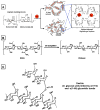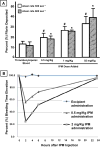Biomaterials and Advanced Technologies for Hemostatic Management of Bleeding
- PMID: 29164804
- PMCID: PMC5831165
- DOI: 10.1002/adma.201700859
Biomaterials and Advanced Technologies for Hemostatic Management of Bleeding
Abstract
Bleeding complications arising from trauma, surgery, and as congenital, disease-associated, or drug-induced blood disorders can cause significant morbidities and mortalities in civilian and military populations. Therefore, stoppage of bleeding (hemostasis) is of paramount clinical significance in prophylactic, surgical, and emergency scenarios. For externally accessible injuries, a variety of natural and synthetic biomaterials have undergone robust research, leading to hemostatic technologies including glues, bandages, tamponades, tourniquets, dressings, and procoagulant powders. In contrast, treatment of internal noncompressible hemorrhage still heavily depends on transfusion of whole blood or blood's hemostatic components (platelets, fibrinogen, and coagulation factors). Transfusion of platelets poses significant challenges of limited availability, high cost, contamination risks, short shelf-life, low portability, performance variability, and immunological side effects, while use of fibrinogen or coagulation factors provides only partial mechanisms for hemostasis. With such considerations, significant interdisciplinary research endeavors have been focused on developing materials and technologies that can be manufactured conveniently, sterilized to minimize contamination and enhance shelf-life, and administered intravenously to mimic, leverage, and amplify physiological hemostatic mechanisms. Here, a comprehensive review regarding the various topical, intracavitary, and intravenous hemostatic technologies in terms of materials, mechanisms, and state-of-art is provided, and challenges and opportunities to help advancement of the field are discussed.
Keywords: biomaterials; hemostasis; platelets; transfusion; wound dressings.
© 2017 WILEY-VCH Verlag GmbH & Co. KGaA, Weinheim.
Conflict of interest statement
Figures














Similar articles
-
Hemostatic biomaterials to halt non-compressible hemorrhage.J Mater Chem B. 2022 Sep 28;10(37):7239-7259. doi: 10.1039/d2tb00546h. J Mater Chem B. 2022. PMID: 35674315 Review.
-
Transfusion biomaterials for hemostasis.J Thromb Haemost. 2025 Mar;23(3):790-803. doi: 10.1016/j.jtha.2024.11.030. Epub 2024 Dec 13. J Thromb Haemost. 2025. PMID: 39675569 Review.
-
Peptide-immobilized starch/PEG sponge with rapid shape recovery and dual-function for both uncontrolled and noncompressible hemorrhage.Acta Biomater. 2019 Nov;99:220-235. doi: 10.1016/j.actbio.2019.08.039. Epub 2019 Aug 23. Acta Biomater. 2019. PMID: 31449930
-
Platelet-Inspired Intravenous Nanomedicine for Injury-Targeted Direct Delivery of Thrombin to Augment Hemostasis in Coagulopathies.ACS Nano. 2022 Oct 25;16(10):16292-16313. doi: 10.1021/acsnano.2c05306. Epub 2022 Aug 2. ACS Nano. 2022. PMID: 35916497 Free PMC article.
-
Engineered Hemostatic Biomaterials for Sealing Wounds.Chem Rev. 2022 Aug 10;122(15):12864-12903. doi: 10.1021/acs.chemrev.1c01015. Epub 2022 Jun 22. Chem Rev. 2022. PMID: 35731958 Review.
Cited by
-
Application and outlook of topical hemostatic materials: a narrative review.Ann Transl Med. 2021 Apr;9(7):577. doi: 10.21037/atm-20-7160. Ann Transl Med. 2021. PMID: 33987275 Free PMC article. Review.
-
A Self-Assembly Pro-Coagulant Powder Capable of Rapid Gelling Transformation and Wet Adhesion for the Efficient Control of Non-Compressible Hemorrhage.Adv Sci (Weinh). 2024 Jan;11(4):e2306289. doi: 10.1002/advs.202306289. Epub 2023 Dec 3. Adv Sci (Weinh). 2024. PMID: 38044313 Free PMC article.
-
Advances in Biomaterials and Technologies for Vascular Embolization.Adv Mater. 2019 Aug;31(33):e1901071. doi: 10.1002/adma.201901071. Epub 2019 Jun 6. Adv Mater. 2019. PMID: 31168915 Free PMC article. Review.
-
Zeolite in tissue engineering: Opportunities and challenges.MedComm (2020). 2020 May 19;1(1):5-34. doi: 10.1002/mco2.5. eCollection 2020 Jun. MedComm (2020). 2020. PMID: 34766107 Free PMC article. Review.
-
Cuboidal tethered cyclodextrin frameworks tailored for hemostasis and injured vessel targeting.Theranostics. 2019 Apr 13;9(9):2489-2504. doi: 10.7150/thno.31159. eCollection 2019. Theranostics. 2019. PMID: 31131049 Free PMC article.
References
Publication types
MeSH terms
Substances
Grants and funding
LinkOut - more resources
Full Text Sources
Other Literature Sources
Molecular Biology Databases

